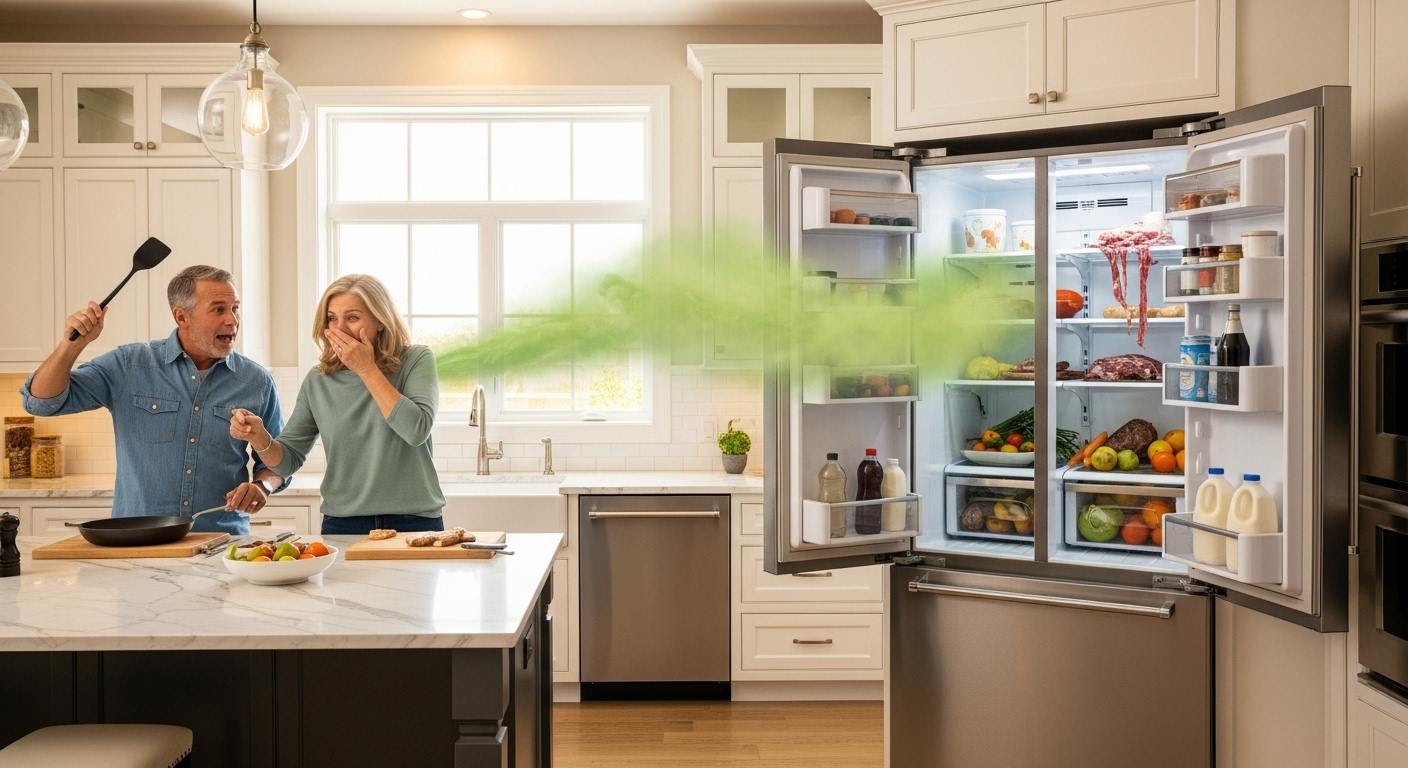Essential Tips to Keep Your Appliance Running Efficiently
Your refrigerator is one of the hardest-working appliances in your home, running 24 hours a day, 365 days a year. Proper maintenance can extend its lifespan from the typical 10-15 years to 20 years or more, while also reducing energy costs and preventing costly repairs. Despite its importance, the refrigerator is often the most neglected appliance when it comes to routine care.
Why Refrigerator Maintenance Matters
Regular maintenance delivers multiple benefits that justify the small time investment required. A well-maintained refrigerator operates more efficiently, potentially saving you $100 or more annually on electricity bills. Preventive care catches small problems before they become expensive repairs, and proper maintenance keeps your food at safe temperatures, reducing the risk of spoilage and foodborne illness.
Additionally, routine cleaning and care prevent odors from developing and keep your refrigerator looking and smelling fresh. Most importantly, regular maintenance can add years to your appliance’s lifespan, delaying the need for a costly replacement.
Monthly Maintenance Tasks
Interior Cleaning
Clean the interior of your refrigerator at least once a month, or more frequently if spills occur. Start by removing all food items, checking expiration dates as you go. Take out removable shelves, drawers, and bins, and wash them in warm, soapy water. For stubborn stains or sticky spills, let the parts soak for a few minutes.
Wipe down the interior walls, ceiling, and floor of the refrigerator with a solution of two tablespoons of baking soda mixed with one quart of warm water. This natural cleaner effectively removes odors without leaving chemical residues that could affect food. Pay special attention to corners, crevices, and the area around door seals where crumbs and spills tend to accumulate.
Clean the door shelves and compartments thoroughly, as these areas often harbor spills from condiment bottles and drink containers. Dry all surfaces completely before replacing shelves and food items to prevent moisture buildup that can lead to mold.
Door Seal Inspection and Cleaning
The door gaskets or seals are critical for maintaining proper temperature and energy efficiency. Inspect them monthly for cracks, tears, or signs of wear. Clean the seals with warm, soapy water and a soft cloth, getting into all the folds where dirt and food particles accumulate.
To test if your door seals are working properly, close the door on a dollar bill so that half is inside and half is outside. If you can pull the bill out easily, the seal may be weak and need replacement. Repeat this test around the entire perimeter of each door.
If seals are dirty but intact, cleaning alone may improve their effectiveness. For seals that have become stiff or lost their pliability, applying a thin layer of petroleum jelly can help restore flexibility and improve the seal.
Temperature Check
Verify that your refrigerator maintains the proper temperature. The ideal refrigerator temperature is between 37°F and 40°F (3°C to 4°C), while the freezer should be at 0°F (-18°C). Use an appliance thermometer to check, as the built-in thermostat may not always be accurate.
Place the thermometer in a glass of water in the center of the refrigerator for several hours, or overnight, for the most accurate reading. In the freezer, place the thermometer between frozen packages. If temperatures are outside the ideal range, adjust the thermostat and recheck in 24 hours.
Quarterly Maintenance Tasks
Condenser Coil Cleaning
The condenser coils release heat from inside your refrigerator, and they’re one of the most important components to maintain. When coils become coated with dust, pet hair, and debris, the refrigerator must work harder to cool, increasing energy consumption and potentially shortening the compressor’s lifespan.
Most refrigerators have coils located either on the back of the unit or underneath behind a front grille. For rear-mounted coils, unplug the refrigerator and carefully pull it away from the wall. Use a coil brush (available at hardware stores) or vacuum with a brush attachment to remove dust and debris. Work gently to avoid bending the coils.
For coils located underneath, remove the front grille and use a coil brush or vacuum to clean the coils. This location tends to accumulate more dust and pet hair, so clean thoroughly. Some newer refrigerators have sealed coil systems that don’t require cleaning, so check your manual to confirm.
After cleaning, vacuum the floor area behind and under the refrigerator before pushing it back into place. Leave at least two inches of clearance between the wall and the back of the refrigerator to ensure proper air circulation.
Drain Pan and Drain Hole Cleaning
Most refrigerators have a drain pan located underneath the unit that collects condensation water. Over time, this pan can develop mold, bacteria, and unpleasant odors. Remove the front grille and locate the drain pan, then carefully slide it out.
Wash the drain pan thoroughly with hot, soapy water, using a brush to scrub away any buildup. Rinse well and dry completely before replacing. Some drain pans can’t be removed, in which case you’ll need to clean them in place using a long, flexible brush and cleaning solution.
Check the drain hole inside the refrigerator (usually located at the back, bottom of the fresh food compartment) for clogs. This small opening allows defrost water to drain to the pan below. If it’s clogged, water can pool inside the refrigerator or leak onto your floor. Use a pipe cleaner or turkey baster filled with warm water to flush the drain and clear any blockages.
Ice Maker and Water Dispenser Maintenance
If your refrigerator has an ice maker or water dispenser, clean these features quarterly. For the ice maker, turn it off and remove the ice bin. Wash the bin thoroughly with warm, soapy water and dry it completely. Wipe down the ice maker mechanism with a damp cloth, being careful around any electrical components.
Discard old ice that’s been sitting for more than a week, as it can absorb odors from other foods. Fresh ice should be clear or slightly cloudy white—if it has an off color or odor, it’s time for a thorough cleaning.
For water dispensers, clean the nozzle and surrounding area with a soft cloth and warm, soapy water. Use a small brush, like a toothbrush, to clean around and inside the dispenser nozzle where mineral deposits and bacteria can accumulate. Run several cups of water through the dispenser after cleaning to rinse away any cleaning solution.
Semi-Annual Maintenance Tasks
Water Filter Replacement
Replace your refrigerator’s water filter every six months, even if the indicator light hasn’t activated. Over time, filters become saturated with contaminants and can actually begin releasing trapped particles back into your water. Mark your calendar or set a reminder on your phone to ensure timely replacement.
After installing a new filter, run two to three gallons of water through the dispenser to flush out any carbon particles from manufacturing and remove air from the lines. This typically takes about five minutes of continuous water flow.
Air Filter Replacement
If your refrigerator has a replaceable air filter (usually found on the back wall of the fresh food compartment), replace it every six months. These filters remove odors and help keep food fresher by filtering the circulating air. Even if you don’t notice odors, the filter’s effectiveness diminishes over time.
Deep Freezer Cleaning and Defrosting
If you have a manual defrost freezer, defrost it when ice buildup exceeds one-quarter inch. Excess ice reduces efficiency and available storage space. For automatic defrost freezers, perform a deep cleaning semi-annually by removing all items, wiping down all surfaces, and checking for any ice buildup around vents or in corners.
Use this opportunity to organize your freezer contents, discarding anything past its prime. Freezer-burned items, mystery packages, and items stored longer than recommended should be tossed. A well-organized freezer is more efficient since air can circulate freely.
Annual Maintenance Tasks
Complete Appliance Inspection
Once a year, perform a thorough inspection of your entire refrigerator. Check all shelves and drawers for cracks or damage that could lead to future problems. Inspect the door hinges to ensure they’re tight and the doors close properly. Loose hinges can cause alignment issues that prevent proper sealing.
Examine the power cord for any signs of damage, fraying, or wear. Check that the refrigerator is level by placing a level on top—an unlevel refrigerator can cause doors to swing open or not seal properly. Adjust the leveling feet as needed.
Look for any signs of water damage on the floor around or under the refrigerator, which could indicate a leak in the water line, drain pan, or defrost system. Address any water issues immediately to prevent floor damage and mold growth.
Water Line Inspection
If your refrigerator has a water line connection for the ice maker or water dispenser, inspect it annually. Check for any signs of leaks, corrosion, or wear. Ensure all connections are tight and secure. If you have a plastic water line, consider upgrading to a braided stainless steel line, which is more durable and less likely to leak or burst.
Turn off the water supply valve and back on again to verify it’s working properly. A stuck or failing shut-off valve can cause problems if you ever need to disconnect the water supply quickly.
Professional Inspection
Consider scheduling a professional appliance inspection every few years, especially for older refrigerators. A trained technician can spot potential problems that aren’t obvious to homeowners, check refrigerant levels, test the compressor and other components, and ensure everything is operating as it should.
Ongoing Best Practices
Beyond scheduled maintenance tasks, following daily best practices keeps your refrigerator running optimally. Don’t overfill the refrigerator—air needs to circulate freely for even cooling. As a general rule, keep it about three-quarters full for optimal efficiency.
Similarly, don’t block air vents inside the refrigerator or freezer with food items, as this disrupts air flow and creates warm spots. Keep the refrigerator away from heat sources like ovens, dishwashers, and direct sunlight, which force it to work harder to maintain proper temperature.
Check door seals each time you close the refrigerator—make sure doors close completely and nothing is preventing a tight seal. Clean up spills immediately to prevent odors, bacteria growth, and sticky residue that becomes harder to remove over time.
Allow hot foods to cool to room temperature before placing them in the refrigerator, as hot foods raise the internal temperature and force the appliance to work harder. However, don’t leave perishable foods at room temperature for more than two hours for food safety reasons.
Energy Efficiency Tips
Several maintenance-related practices can significantly reduce your refrigerator’s energy consumption. Keeping the condenser coils clean, as mentioned earlier, is one of the most effective ways to improve efficiency. Ensuring proper door seals prevents cool air from escaping and warm air from entering.
Maintaining proper temperature settings prevents the refrigerator from working unnecessarily hard—remember, every degree below the recommended 37-40°F range increases energy consumption by about five percent. Keeping the refrigerator reasonably full helps it maintain temperature more efficiently, as the stored items retain cold and reduce the amount of warm air entering when you open the door.
Position your refrigerator with adequate clearance—at least two inches from the wall and away from heat sources. If your refrigerator is in an unconditioned space like a garage, it will work harder in extreme temperatures and may not operate properly in very cold conditions.
Troubleshooting Common Issues
Regular maintenance helps prevent many common refrigerator problems, but knowing how to address issues when they arise can save you from unnecessary service calls. If your refrigerator is running constantly, check the door seals, ensure the coils are clean, and verify the temperature settings. Constant running often indicates the unit is working harder than necessary due to poor maintenance.
For unusual noises, first check if the refrigerator is level and that nothing is touching the back or sides. Clean the condenser fan if accessible. Some humming and clicking is normal, but loud buzzing, rattling, or grinding sounds warrant professional attention.
If water is pooling inside the refrigerator, the drain hole is likely clogged. If water is leaking onto the floor, check the drain pan, water line connections, and ensure the refrigerator is level so water can properly drain to the pan.
Temperature fluctuations often result from blocked air vents, overfilling, or failing door seals. Check these issues first before assuming there’s a mechanical problem.
When to Call a Professional
While much of refrigerator maintenance can be handled by homeowners, certain issues require professional expertise. Call a technician if you notice the compressor running hot or not running at all, if there’s frost buildup in the freezer despite automatic defrost, or if the refrigerator isn’t cooling despite being plugged in and set properly.
Refrigerant leaks require immediate professional attention—signs include poor cooling despite everything else working normally, hissing sounds, or oily residue around the compressor. Any electrical issues such as blown fuses, tripped breakers, or burning smells should be addressed by a professional immediately.
The Bottom Line
Refrigerator maintenance is neither difficult nor time-consuming, yet it offers substantial returns in extended appliance life, reduced energy costs, and prevention of expensive repairs. By dedicating just a few minutes monthly, an hour quarterly, and a couple of hours annually to proper care, you can keep your refrigerator running efficiently for decades.
Treat maintenance as an investment rather than a chore. The small amount of time you spend cleaning coils, checking seals, and replacing filters pays dividends in reliability and performance. A well-maintained refrigerator is a dependable refrigerator, one that will faithfully preserve your food and serve your family for many years to come.
Start today by checking your door seals and scheduling your next coil cleaning. Your refrigerator—and your wallet—will thank you.



